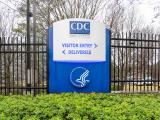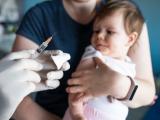This is the third in a series of reports marking the first anniversary of novel H1N1 pandemic influenza. The first and second articles appeared on Apr 23 and Apr 26.
Apr 30, 2010 (CIDRAP News) – As the biggest public health initiative in the history of the US Centers for Disease Control and Prevention (CDC), the H1N1 pandemic vaccination campaign encountered stiff headwinds with scarce supplies and complex messaging but ended up reaching about a quarter of the US population and, some say, smoothing the path for future immunization efforts.
About a month after the pandemic flu virus emerged, federal officials ordered vaccines from five different companies at a price tag of $650 million, with $287million more for adjuvants that could be needed if the virus turned out to be severe or if vaccine potency was lower than expected.
While manufacturers struggled with a low-yielding seed strain, public health experts were anxious about the next daunting step: getting the vaccine into people's arms. Their task was to launch the first mass vaccination campaign since the much-maligned swine flu vaccine of 1976, against steady undercurrents of antivaccine sentiment and general mistrust of government.
Charting a campaign course
Taking a page from the playbook of the CDC's Vaccines for Children (VFC) program, which distributes vaccines for administration to uninsured and Medicaid-eligible children, the agency contracted with its VFC partner, McKesson Corp., as the central vaccine distributor for the pandemic vaccine. The CDC stipulated that the vaccine would be allocated to states on a pro-rata basis and that states would designate providers, including local health departments, medical clinics, and other partners. The agency projected that the vaccine would be sent to 90,000 different sites, which the CDC last August said made the pandemic vaccine campaign the biggest public health venture in its history.
In July, Kathleen Sebelius, secretary of the US Department of Health and Human Services (HHS), said she expected a fall launch for the campaign and asked states to prepare their plans and identify vaccination sites. Though the Obama administration had earmarked $260 million to help states support the vaccine campaign, the federal government's request came at a time when the nation's economic downturn had taken a toll on state budgets, which alongside years of shrinking federal funds had eroded the public health workforce.
The impact of the effort on local publish health agencies was glimpsed at a congressional hearing on the pandemic vaccine last November, when Dr Rob Fulton, director of the St. Paul–Ramsey County Public Health Department in Minnesota, told legislators that 135 of his department's 320 employees were involved in the H1N1 response at least part-time, which took time from their regular work.
Aside from planning a massive vaccination campaign, health officials had a complex task in pitching it to the public. What they had was a seasonal flu vaccine campaign that needed to be launched about a month earlier than usual, followed closely by the pandemic vaccine initiative. They weren't sure if people would need a second dose of the pandemic version. As public health recommendations evolved and research findings on the pandemic vaccine emerged, the message became even more complex: the risk groups recommended for the two vaccines were slightly different, and children younger than 10 would need a second dose of the pandemic vaccine.
Anticipating the public's concern about the new vaccine's safety, CDC officials added several extra monitoring systems to its vaccine safety network and conducted focus groups to help craft its vaccine pitch, especially to parents. Officials with HHS and CDC also held tabletop exercises with journalists and bloggers to help sketch out scenarios and resulting communications challenges, such as explaining baseline rates of health events such as neurologic conditions and miscarriages, that might thwart the vaccine campaign.
At the end of a tabletop exercise last September, Bill Hall, news director for HHS, summed up the challenge in talking to the public about the need for the vaccine. "The public wants a simple message, but nothing about flu is simple," he said.
Production delays, fall wave cause turbulence
By the middle of August, it became clear that the amount of pandemic vaccine available for an October launch would be much lower than expected: 45 million doses by the middle of the month instead of the 120 million doses projected earlier. Federal officials said the low-yielding vaccine virus strain and glitches with new production lines were hampering manufacturers.
With pandemic flu infections spreading across the country in September, fueled by students returning to school, and the realization that the vaccine would launch later than expected, federal officials braced themselves and warned the public to expect some bumps on the road, with demand exceeding supply. At a press conference on Sep 25, CDC Director Dr Tom Frieden said, "In the coming weeks there is going to be some roughness. We don't know what uptake will be, and we also don't know which states will have problems—but we're working hard to identify them and help them overcome difficulties."
However, the good news was that researchers found that one dose was protective for most people, instead of the two doses public health officials had expected.
When states got their first vaccine shipments in early October, it was the inhaled version made by MedImmune, which encountered few production problems. The mist version of the vaccine is approved only for people ages 2 through 49, and is contraindicated for many in the CDC's priority groups, such as pregnant women and people with underlying medical conditions
In the face of vaccine shortages, state and local health officials had to reschedule flu vaccination clinics, and states and hospitals grappled with how to ensure that the meager supplies they got during the first months of the campaign would reach those at highest risk of flu complications. In early November with the pandemic infections widespread in all but two states, Frieden told Congress that the vaccine shortage would probably outlast the flu wave.
However, balancing out anxieties about production delays was good news about the new vaccine's safety: The first report in mid November suggested the safety profile was similar to that of the seasonal flu vaccine.
Campaign hits stride
Pandemic vaccine shipments finally hit their stride in December, reaching the 100 million-dose milestone by the middle of the month. States expanded their vaccination efforts outside the priority groups, and the breathing room allowed federal officials to make their first assessments of the campaign. Sebelius, at a Dec 17 press briefing, told reporters that partnerships between federal officials and their state and local counterparts would yield long-term benefits. "One of the key lessons we learned is you can't mount a public health response only from the beltway," she said.
Anne Schuchat, MD, director of the CDC's National Center for Immunization and Respiratory Diseases, urged state and local health officials to do everything they could to put vaccine in the path of people, and they responded, setting up immunization clinics in nontraditional venues such as shopping malls, airports, subway stations, and sporting events. Also, Schuchat has said that 40 states used school-based vaccinations to some degree, and the CDC recently reported that three of the four states that had the highest vaccine uptake were among those with school-based vaccine clinics.
In early April, the CDC estimated that the pandemic vaccine campaign had reached 24% to 27% of Americans, or between 72 million and 81 million people, by the end of February. And as a bonus, flu risk messages and the early availability of the seasonal flu vaccine seem to have paid off in record uptake, with nearly all of the 114 million doses used.
Solid reviews for centralized distribution
Public health officials who were close to or involved in the vaccination campaign said it worked well and provided useful lessons for the years ahead.
Dr Paul Etkind, senior analyst for immunization with the National Association of City and County Health Officials (NACCHO), told CIDRAP News that despite early vaccine availability problems, the central distribution system worked well. The centralized system is providing good data, compared to the normal seasonal flu distribution system, on how many and where people were vaccinated. "We're finding out what the gaps were and what populations and areas were underserved," he said.
Considering the complexity of vaccination messages, health officials—between the pandemic and seasonal vaccines—were able to put an extraordinary amount of vaccine into people's arms, Etkind said. Though everyone wishes the pandemic vaccine uptake was higher, "final numbers might show that we may have knocked down fatalities," he added.
One particular bright spot of the campaign was the response of pregnant women, who are at risk for severe illness with H1N1, Dr. Daniel B. Jernigan, a CDC flu expert, told CIDRAP News.
"That's an area where we know we've not had a great vaccination record" in the past, he said. "I think one success of the 2009 H1N1 experience is that a whole lot more pregnant women got vaccinated than before." He thinks obstetricians and gynecologists are now more aware of the risk that flu poses for pregnant women.
Enhanced safety monitoring boosted the strength of the campaign despite disinformation about the vaccine that made the immunization task more difficult, Etkind said. "There was a lot of talk about another 1976 with new vaccine and the risk of Guillain-Barre syndrome (GBS). And yet with enhanced surveillance that included more resources and faster response, we didn't see any of those things [that antivaccine activists] claimed ahead of time," he said. "It was a safe vaccine and seemingly effective."
Kris Ehresmann, RN, MPH, immunization director at the Minnesota Department of Health in St. Paul, told CIDRAP News that the centralized system that took shape looked very different from the mass dispensing model that many public health officials had envisioned when plotting out their pandemic plans in the years before. Though she said the centralized system made sense, many had envisioned mass dispensing through public health clinics, which would have meant fewer sites. "This was a paradigm shift for many people. That challenge was reordering the world in the midst of a crisis," she said. "But we got the vaccine to so many different sites."
When federal officials outlined the plans for pro-rata distribution, with each state deciding how best to distribute the vaccine to providers, some feared that the process might become chaotic, she said. She added that Minnesota was able to target its vaccine to the CDC's highest priority groups, and as a result the uptake numbers so far look good.
Partnership investments shone
Etkind said the importance of vaccine partnerships was a valuable lesson, and working with new providers, different state agencies, pharmacies, and social service agencies will pay dividends during future immunization efforts. "That was a new high, another thing to be very happy about and proud of."
He singled out partnerships with schools as particularly important, especially given recent expansions in seasonal flu vaccine recommendations to include everyone except babies younger than 6 months and children's role in the spread of the virus. "School locations can be a very effective way to meet that new demand," Etkind said.
Ehresmann said the new relationships with providers have gotten her department thinking about how best to set up a seasonal flu vaccination system that is relatively painless to administer. "We've got lots of ideas," she said.
Communications challenges remain
Communications regarding the vaccine were a big challenge, and Etkind said the CDC deserves praise for the tremendous amount of work it did in testing messages with focus groups. "Some of the messages made it through, and the right people came to be vaccinated," he said. "But it's an unfinished story, and there is always room for improvement." He added that there are still parts of the population that aren't as receptive to the vaccine message, such as minority groups.
Health officials have a big task in front of them in reestablishing a sense of trust in government, he said. "This came to the forefront with flu vaccination. Hopefully, we can acknowledge this and learn to deal with it in a constructive fashion."
Ehresmann said seasoned public health officials probably weren't surprised when the vaccine was delayed, because they expect problems to crop up during a crisis, but the shortage presented some unique communications challenges. Sometimes the message at the federal level was that states had vaccine available at a time when supplies were very scarce. "You don't want to contradict your partners, but there wasn't plenty of vaccine, yet we had to portray somehow that we hadn't messed up," she said.
The lesson from the vaccine shortage, Ehresmann said, is "Underpromise and overdeliver."
Another lesson that surfaced during the campaign is that vaccination messages to adults need some rethinking, Etkind said. Opinion polls from Harvard showed that adults were likely to have their children vaccinated, but didn't believe they were at risk for the disease. "Flu doesn't recognize differences in age or professional differences. And part of what protects them [children] is that parents are also protected," he added.
Ehresmann predicted that the next communication challenge will be how to portray the pandemic flu risk and the need for vaccination during the transition time as the pandemic strain evolves into more of a seasonal flu pattern.
See also:
Jul 9, 2009, CIDRAP News story "Sebelius expects launch of H1N1 vaccination drive in fall"
Aug 10, 2009, CIDRAP News story "States to designate providers to give H1N1 vaccines"
Sep 3, 2009, CIDRAP News story "Feds engage media on pandemic vaccine communication"
Sep 25, 2009, CIDRAP News story "As H1N1 sweeps US, officials brace for vaccine launch"
Oct 16, 2009, CIDRAP News story "US H1N1 vaccine delayed as cases and deaths rise"
Nov 4, 2009, CIDRAP News story "CDC says vaccine shortage will likely outlast current H1N1 wave"
Dec 17, 2009, CIDRAP News story "Vaccine availability opens up as doses approach 100 million"
Feb 4 CIDRAP News story "US H1N1 vaccine uptake estimated at 75 million"


















